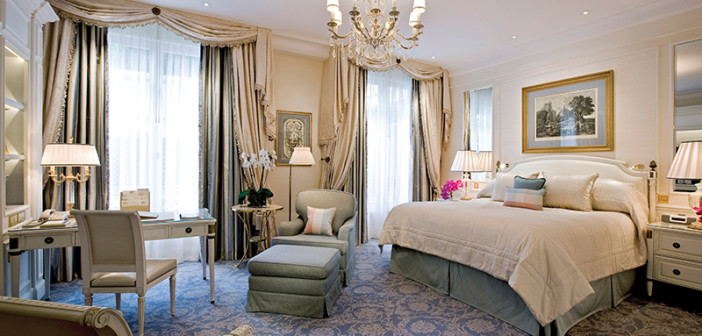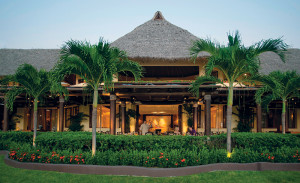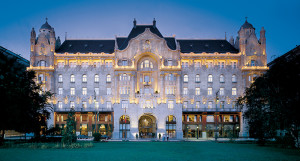NEW YORK—Luxury-hotel operator Four Seasons Hotels & Resorts has been raising its posh profile with additional property openings and significant renovations, with plans in place for an increased presence over the next several months.
The Four Seasons Maldives Private Island Voavah at Baa Atoll, Four Seasons Hotel Tianjin in China and the Four Seasons Resort The Nam Hai in Hoi An, Vietnam opened last month.
This year will see the debut of Four Seasons Hotel London at Ten Trinity with 100 guestrooms and 41 residences. The Four Seasons Hotel at The Surf Club will follow in March in the North Beach area of Miami, with 77 rooms and five cabana rooms. Next year, the Four Seasons Hotel Kuwait at Burj Alshaya will be part of the 1.5-million-sq.-ft. Burj Alshaya Centre in downtown Kuwait City, Kuwait. And set to re-open this year after major renovations, the Four Seasons Resort Seychelles at Desroches Island will feature 40 beach suites and 11 private residence villas.
Expansion and renovation were key topics at a recent gathering here at the Five-Star hotel operator’s newest Manhattan presence, the Four Seasons New York Downtown, where dozens of hotel general managers and executives were on hand from the luxury brand’s domestic and global properties, which now number more than 100.
According to Michael Law, director of marketing for the 189-room host hotel located in the Financial District, business has been robust.
“Considering that we opened in October, which is a very busy month in New York City, it’s been very active and very busy at the hotel. We had a long lead-up to this hotel; a lot of people knew it was coming online. We did a very strong PR effort here in the local community, within the region and internationally as well,” said Law, noting one draw for the hotel is the debut of CUT, Chef Wolfgang Puck’s first Big Apple restaurant.
The bulk of the business for the hotel at this time of year is business travelers, Law said, although there are promotions to bring in leisure travelers as well.
“We think it’s important for people to get to know the Downtown area, rediscover what’s happening here. A lot of people have coined this ‘The new New York,’ with everything from the Oculus [the new transportation hub at the World Trade Center site], the proximity to the waterfront, a new Saks Fifth Avenue, tremendous amounts of restaurants—Nobu is opening up in the first quarter. There’s an awful lot for people to do here: families, couples. We’d just love for people to come discover it.”
Four Seasons New York Downtown also has 157 residences above the hotel, 80% of which, at press time, were sold, said Law.
Four Seasons is already well known in the city for its I.M. Pei-designed, 368-room property on East 57 St., and its previous management of The Pierre nearby.
“Four Seasons had the luxury of having two hotels previously, and now has two very different hotels in style and feel. In size, the [Downtown property] is much more contemporary and smaller in size. But the downtown location is its own destination, so I think travelers now have an option. Actually, they could even do two nights here and two nights there and experience all of New York,” said Law. “As a new-build hotel, it has some of the latest technology, very contemporary design; it’s a perfect addition to the portfolio and a perfect sister property to the Four Seasons in Midtown.”
At the Four Seasons Resort Punta Mita in Mexico, renovations have dominated the agenda. Director of Sales and Marketing Thomas Citterio indicated among the major projects has been the complete redesign of the beach area, the construction last year of a new spa and the addition of two Presidential Suites.
“We have a plan to redo the restaurant and renovate the guestrooms [173 rooms and suites]. Every year, there’s something going on,” said Citterio.
On the service side, the DoS/M said the property has implemented a “pets program,” offers an “ultimate tequila tour” where guests are transported via private helicopter to the Jose Cuervo distillery in Tequila, Mexico, and has developed interesting F&B programs—for example, cooking food in an underground earth oven.
Citterio said business has been good, despite some traveler perceptions regarding the country. He noted earlier in 2016, the spread of the mosquito-inflicted Zika virus raised some concerns. “There was no case in [our]area. The only case was in Guadalajara, which is a four-and-a-half-hour drive from where we are. [Concerns] hit us for a few months: January, February, March. But now, not a lot of people talk about it anymore. So, in general, yes, business is good,” said Citterio.
He added development has increased in the area, with other hotel companies, such as Fairmont Hotels & Resorts and One&Only, coming in. “This is going to be great for the area,” said the DoS/M.
The majority of the Punta Mita property’s guest mix is transient and group, the latter largely incentive business from the United States. “We also have corporate groups like product presentations, meetings from the national markets. Mexico also gives us a lot of leisure business over the summer months. But the U.S. market is the strongest for us,” said Citterio.
Yves Giacometti, general manager of the Four Seasons Hotel Gresham Palace Budapest in Hungary indicated the industry mantra of “location, location, location” remains critical on a global basis.
“Budapest is a very exciting city. It’s still in the full process of revamping and restoring the destination. The authorities have been very active in promoting the destination as very vibrant, full of culture. The dining scene is becoming very important in the city with a lot of talent culinary-wise. In fact, at the hotel, we have a Hungarian chef who participated recently at the Bocuse d’Or [the world chef championship named for Chef Paul Bocuse], and a sommelier we have has been named for the third year in a row as the best sommelier in Hungary,” said the GM.
And part of that scene is the 179-room Four Seasons Hotel Gresham Palace Budapest, housed in an architecturally elaborate Art Nouveau building in existence for more that 100 years and which once served as the foreign headquarters of London-based Gresham Life Assurance Co. in the early 20th century, with various transitions across the decades.
In the early 21st century, the landmark building on Szechenyi Square became a hotel and received a careful restoration to return it to its original appearance. “Today, you’ll find many of the details of the original design, recreated by the original manufacturers, whether ceramic work, stained glass or iron work. So we carry a historic package in the building, and this is what we have been doing since we opened the hotel about 12 years ago,” Giacometti told Hotel Business.
Four Seasons has also restored the guestrooms and recently revamped its restaurant into a brasserie. “It’s very energetic, very vibrant. There’s a rotisserie, bakery, a wine corner and a bar in the center of the restaurant, which makes it a very prominent activity for locals and gives great exposure of the hotel to the community, which has a lot of respect for the building,” he said.
Additionally, Four Seasons Hotel Gresham Palace Budapest is redefining its public spaces (within historic-structure guidelines). For example, during the recent holiday season, part of the lobby had been given over to a dozen or so local suppliers to create a mini-Christmas market similar to those found in many European countries in December. “So we get a lot of local people coming into the hotel, enjoying the beauty of the building in the Christmas spirit,” said the GM, who noted the majority of guest business is leisure.
“We also get a lot of cruise business—we sit on the banks of the Danube—[sailing]from north of Germany all the way down to the Black Sea, stopping in Budapest for a few days,” said Giacometti, adding: “A lot of Americans also come to find their roots, their ancestors. There’s a lot of history that came from Hungary with the immigrants who went to the United States.”
According to José Silva, general manager of the Four Seasons Hotel George V, Paris and regional VP/Spain, Portugal, Switzerland and France, the iconic property, opened in 1928, recently went through a major renovation.
“Luxury cannot be the same for years. My goal in coming to the property—I’m there two years—was to reposition the hotel for the next 20 years. Toward that, we injected €80 million (approximately $84.7 million) into transforming all the public areas. I believe that hotels are reinvented through their public areas. The first goal in the restaurant scene was to obtain the third Michelin star. The hotel had been looking for the past nine years to re-achieve its third star and we got it in February by Chef Christian Le Squer (for Le Cinq). Then we opened a second restaurant [Le George]. It’s a Mediterranean-fusion restaurant; very modern, similar to Zuma, Nobu, but it’s all Mediterranean—a combination of Italy, France and Spain— and it’s a sharing concept. It’s the talk of the town right now,” said Silva, noting Chef Simone Zanoni oversees the menu.
Adding to the F&B experience at Four Seasons George V, Paris, the GM opened L’Orangerie with a menu by Chef David Bizet. “Our goal at the French brasserie is to achieve the most-affordable two-Michelin-star restaurant in Paris in a luxury hotel. The menu is €95 (approximately $100), and it looks like an upscale brasserie inside a conservatory on the courtyard. We will most probably achieve our first star this coming February and, eventually, our second. I was there with the president of Michelin Guide [recently]and he feels we’re on the way,” he said.
Silva’s vision for the Grande Dame in terms of F&B is not to have a single executive chef managing the hotel’s culinary offerings. “Running institutional food, as I call it,” he said. “So I hired three independent chefs in order to act like three, independent restaurants.”
Silva also wanted to reinvent the George V suites. “We created a collection of what we call private apartments; they look residential, they don’t look like big hotel rooms disguised as suites. We have six of those and they are all different, one from another. We completed that three months ago,” he said.
And currently underway is the transformation of the hotel’s spa, which is being enlarged, a process that is expected to take two years. “But in the meantime, we’ve opened a pop-up spa—we call it the pop-up but it’s a $1-million spa that is being designed by Jeff Leatham, the florist (and the hotel’s artistic director)…it’s the mood and style of Jeff in a spa journey,” said Silva.
The GM acknowledged change for a venerable, internationally known hotel has its challenges, including meeting the needs of long-standing guests who often don’t want to see change to their home away from home.
“It’s been the big dilemma of how great institutions remain current and relevant,” said Silva. “The dilemma is if you don’t change, eventually you lose your positioning. If you change too much, you lose your current patronage. What I tried to do when I arrived was to identify what were the elements that would be part of the DNA of the George V that we shouldn’t change and what were the elements that, in fact, we had an opportunity [to change]to become more current and that the guests already expected, like a second restaurant, something more 21st century, or the suites to be more comfortable for people’s needs, e.g., more-efficient technology and high-speed internet. The hotel has been transformed, but within its DNA. I think that’s the essence of any transformation of any great institution.” HB




